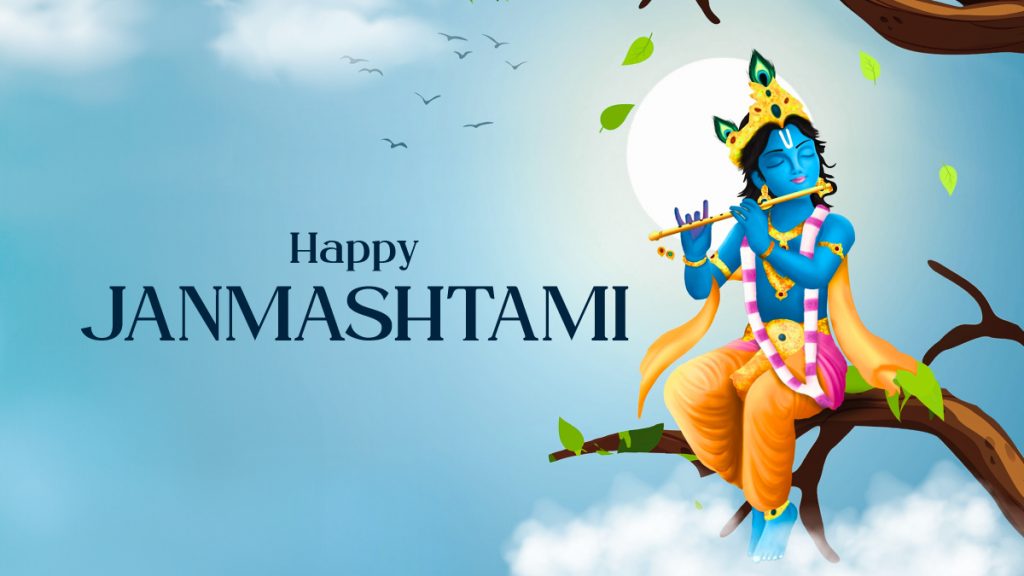Janmashtami, also known as Krishna Janmashtami, is one of the most widely celebrated Hindu festivals in India. It marks the birth of Lord Krishna, the eighth incarnation of Lord Vishnu, who is revered as the protector of dharma (righteousness). Celebrated with great devotion and joy, Janmashtami falls on the eighth day (Ashtami) of the dark fortnight in the month of Bhadrapada (August-September). The festival is marked by fasting, night vigils, devotional singing, and reenactments of Krishna’s playful and heroic deeds.
Janmashtami Dates for 2024, 2025, and 2026
Here are the dates for Janmashtami in the upcoming years:
| Year | Date | Day |
|---|---|---|
| 2024 | 26/08/2024 | Monday |
| 2025 | 16/08/2025 | Saturday |
| 2026 | 04/08/2026 | Tuesday |
The Significance of Janmashtami
Janmashtami celebrates the birth of Lord Krishna, who is believed to have been born in a prison cell in Mathura, Uttar Pradesh, to King Vasudeva and Queen Devaki. His birth is said to have occurred at midnight, during a time of widespread tyranny and evil under the rule of King Kansa. Krishna’s birth symbolised the divine intervention of Vishnu to restore righteousness and defeat evil.
Krishna is worshipped for his wisdom, strength, and playful nature. His teachings, particularly those in the Bhagavad Gita, are central to Hindu philosophy and spirituality. Janmashtami is a joyous occasion for devotees to honour Krishna’s life, his miracles, and his role as the protector of dharma.
How Janmashtami is Celebrated
Janmashtami is celebrated with great enthusiasm and devotion across India. The day is filled with religious rituals, cultural performances, and community events that reflect the love and reverence for Lord Krishna.
- Fasting and Night Vigils: Devotees observe a fast throughout the day, breaking it only at midnight when Krishna is believed to have been born. Temples and homes are beautifully decorated, and special pujas (ritual worship) are conducted. Devotees gather for night vigils (jagarans), where they sing devotional songs (bhajans) and chant mantras in praise of Krishna.
- Midnight Celebrations: At midnight, the birth of Krishna is reenacted with great joy. Temples unveil idols of baby Krishna, often placed in a cradle, and devotees offer prayers, milk, and sweets to the deity. This moment is accompanied by the ringing of bells and singing of hymns, marking the divine birth.
- Ras Leela and Dahi Handi: In several parts of India, particularly in Mathura and Vrindavan (associated with Krishna’s early life), plays known as Ras Leela are performed to depict scenes from Krishna’s life, including his playful interactions with the gopis (milkmaids).In Maharashtra, the tradition of Dahi Handi is a major attraction. Inspired by Krishna’s childhood pastime of stealing butter, young men form human pyramids to reach and break pots filled with curd or butter, which are hung high above the ground.
- Devotional Singing and Dancing: Throughout the day, temples resound with the sounds of bhajans and kirtans, and devotees engage in devotional dances that celebrate the love between Krishna and his devotees.
Janmashtami in Different Parts of India
Janmashtami is celebrated with various regional customs and traditions across India, with each region adding its unique flavour to the festival.
- Mathura and Vrindavan (Uttar Pradesh): The birthplace of Lord Krishna, Mathura, and his childhood home, Vrindavan, are the epicentres of Janmashtami celebrations. The temples in these cities are decorated with flowers and lights, and large crowds gather to participate in the elaborate festivities, including the Ras Leela performances.
- Maharashtra: In Maharashtra, particularly in Mumbai and Pune, the Dahi Handi competition is the highlight of the Janmashtami celebration. Teams of young men compete to break the handi (pot) suspended high above the streets, creating a festive and competitive atmosphere.
- Gujarat: In Gujarat, Janmashtami is celebrated with grand festivities in Dwarka, one of the four major pilgrimages in Hinduism. Devotees visit the Dwarkadhish Temple to offer prayers and participate in the rituals.
- South India: In Tamil Nadu and Karnataka, Janmashtami is celebrated with the drawing of kolam (rangoli) designs outside homes, and the depiction of baby Krishna’s footprints leading into the house, symbolising his presence. Special dishes like seedai and murukku are prepared as offerings to the deity.
Janmashtami – A Celebration of Devotion and Joy
Janmashtami is more than just a religious festival; it is a celebration of life, devotion, and the joyous spirit of Lord Krishna. The festival brings people together in devotion to Krishna’s teachings and his divine playfulness. It serves as a reminder of the importance of love, faith, and righteousness in overcoming challenges and adversity.
As devotees sing, dance, and fast in Krishna’s honour, they also reflect on the deeper philosophical teachings that Krishna imparted through the Bhagavad Gita – the path of duty, devotion, and selflessness. Janmashtami remains a vibrant and cherished festival that continues to inspire and uplift the spirits of Hindus across the world.
Popular FAQs about Janmashtami
- Is Janmashtami a public holiday in India? Yes, Janmashtami is a gazetted public holiday in many states across India. Schools, government offices, and businesses often close for the day to allow people to participate in the festivities.
- What is the significance of Janmashtami in Hinduism? Janmashtami marks the birth of Lord Krishna, the eighth avatar of Lord Vishnu, who is revered for his teachings in the Bhagavad Gita and his role in restoring dharma (righteousness).
- How is Janmashtami celebrated in India? Janmashtami is celebrated with fasting, midnight prayers, devotional singing, Ras Leela performances, and the Dahi Handi competition. Temples and homes are decorated, and devotees reenact the birth of Krishna with great joy.
- What is Dahi Handi, and why is it important during Janmashtami? Dahi Handi is a popular tradition during Janmashtami, especially in Maharashtra. It involves young men forming human pyramids to break a pot filled with curd, symbolising Krishna’s love for butter as a child.

